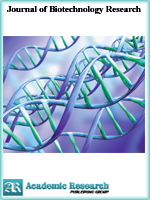Journal of Biotechnology Research
Online ISSN: 2413-3256
Print ISSN: 2413-8878
Print ISSN: 2413-8878
Quarterly Published (4 Issues Per Year)

Archives
Volume 3 Number 6 June 2017
Effect of Mixing Whey Protein with Jameed Past on the Chemical Composition, Rheological and Microbial Properties
Authors: Mohamed Nour-Eldin Farid Hamad ; Magdy Mohamed Ismail ; Reham Kamal El-Menawy
Pages: 42-55
Abstract
Nine treatments of Jameed were made as follow: (A) Jameed made from sheep buttermilk (control), (B) made from goat skim milk, (C) made from goat skim milk+10% (of curd weight) whey protein (WP), (D) made from goat skim milk+15% (of curd weight) WP, (E) made from goat skim milk+20% (of curd weight) WP, (F) made from cow skim milk, (G) made from cow skim milk+10% (of curd weight) WP, (H) made from cow skim milk+15% (of curd weight) WP, and (I) made from cow skim milk+20% (of curd weight) WP Results showed the following; the addition of WP paste (10, 15 and 20%) to goat or cow skim milk didn’t exhibited clear changes in yield values and relatively more acidic, compared to that made without adding it, while, increased increase in WSN, WSN/TN, NPN and NPN/TN values, on the other hand, slightly increased in TS, total protein, ash and salt and decreased fat contents. Incorporation 10, 15 or 20% WP paste with Jameed increased its TVBC, LAB and proteolytic bacteria counts. The highest wettability levels recorded in Jameed samples contained 20% WP paste, while, Jameed contained 20% WP recorded the weakest textural properties values. In Jameed treatments manufactured from goat or cow skim milk with addition of 10, 15 and 20% WP, protein matrices had rigid plate’s structure, little aggregates and more spaces scattered in matrix. Economic study for utilization of WP in Jameed production showed that incorporation of 10 and 15% WP paste with goat or cow skim milk Jameed curd increased the net profit.



